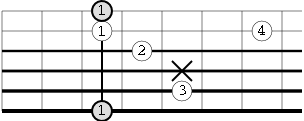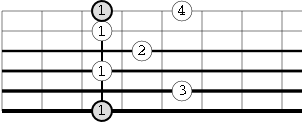
GM7 (G Major Seventh)

or

or

G7 (G Seventh)

or

GM6 (G Major Sixth)
 or
or

G4 (G Fourth) or Gsusp (G Suspended)

G9 (G Ninth)

G7-9 (G Seventh-Ninth)

Discussion of the patterns
The chord patterns for each of the chord variations have been arranged in columns that help to show exactly what is varied.
In the first column, each chord variation is formed by adding a note to
the fundamental major chord. Of course, since we (most of us) have only
4 fingers to work with, this means one of the notes in the original
chord gets left out; but that's OK, since the notes in the original
chord are repeated in different octaves (there are three notes in each
chord and six strings, so at least some of the notes are repeated).
In the second column, the extra note is added by "flating" the root
note on the fourth string - i.e., by moving this note down one or more
frets.
The third column gives a pattern that is a "variant" form, using only
four of the strings and not really being a true "bar" chord since
there's no "bar" across the strings - the notes on the four strings are
fingered individually.
In the major-seventh chord, the note added is the 7th note of the major
scale, which is the note just before the root note, one fret down. In
the first column, this note is added on the second string; in the
second column, this note is added on the fourth string by moving the
root note that was on that string down one fret. The pattern in the
third column is just the pattern in the second column with only four of
the strings used.
The seventh chord is interesting, in that it's just like the
major-seventh chord except that it adds the note that's 2 frets down
from the root note of the chord. This is actually not one of the notes
in the true major scale - it's instead the flatted seventh note, which
is used in the "***" major scale. This scale is just like the major
scale, only uses the flatted seventh note. This scale is frequently
used in blues and rock because the flatted seventh gives the scale an
"edgier" feel. The seventh chord similarly has a "darker" feel than the
major-seventh chord, which is somewhat "brighter". This chord should
probably have been called the "major-flatted-seventh" chord, but for
convenience it's just called the seventh chord, without the "major" or
"flatted". Note that there's a big difference in sound between the
major-seventh and seventh chords.
The major-sixth chord similarly just adds the sixth note of the
scale
to the major chord. This chord is often used in conjunction with the
fundamental major chord and major-seventh chord; the major /
major-seventh / major-sixth / major-seventh / major-sixth progression
is a standard jazz progression.
The fourth chord just adds - you guessed it - the fouth note in the
scale. This note is one fret above the third note, which coincidentally
occurs on the third string in this form; thus the pattern illustrated
just moves the note on the third string up one fret. This chord is also
called G suspended, because it has an incomplete or "suspended" feel to
it - when you hear this chord, you want to hear the straight major
chord after it to finish the progression.
The two ninth chords add the ninth note in the scale. Well, since the
scale repeats after 8 notes, it amounts to adding the second note in
the scale. The straight ninth chord adds the ninth note to the straight
major chord, while the seventh-ninth chord adds the ninth to the
seventh chord.
These same chord variations can be played in the other fundamental forms, too.
Second form
The second form chords are shown at the third fret, making these C
chords. Note, however, that as with the first form chords, the patterns can be played at any position on
the fretboard to form any other chord - A, B, F, etc.
C (C Major)

or

CM7 (C Major Seventh)

or

C7 (C Seventh)

or

CM6 (C Major Sixth)

C4 (C Fourth) or Csusp (C Suspended)

C9 (C Ninth)

CM7-9 (C Major Seventh-Ninth)

C7-9 (C Seventh-Ninth)

Discussion of the patterns
As in the chords of the first pattern, each chord variation adds one or
more notes from the scale to the fundamental major chord. In the first
column, this is accomplished by modifying one of the notes in the major
chord pattern; in the second column, the extra note is added.
Note also that there's one extra chord here, the major-seventh-ninth
chord, which is formed by adding the ninth note to the major seventh.
Third form
The third form chords are shown at the fourth fret, making these E
chords. Note however that the patterns can be played at any position on
the fretboard to form any other chord - A, B, F, etc.
E (E Major)

EM7 (E Major Seventh)

or

E7 (E Seventh)

EM6 (E Major Sixth)

E4 (E Fourth) or Esusp (E Suspended)

E9 (E Ninth)

EM7-9 (E Major-Seventh-Ninth)

Discussion of the patterns
Same deal as before - the chords are all variations on the fundamental
form, with one or two notes added. Note the lame suspended chord, which
uses only 3 strings...
Comments/questions: jsevy@cs.drexel.edu




 or
or  or
or 
 or
or 
 or
or




 or
or 
 or
or 
 or
or 






 or
or 




